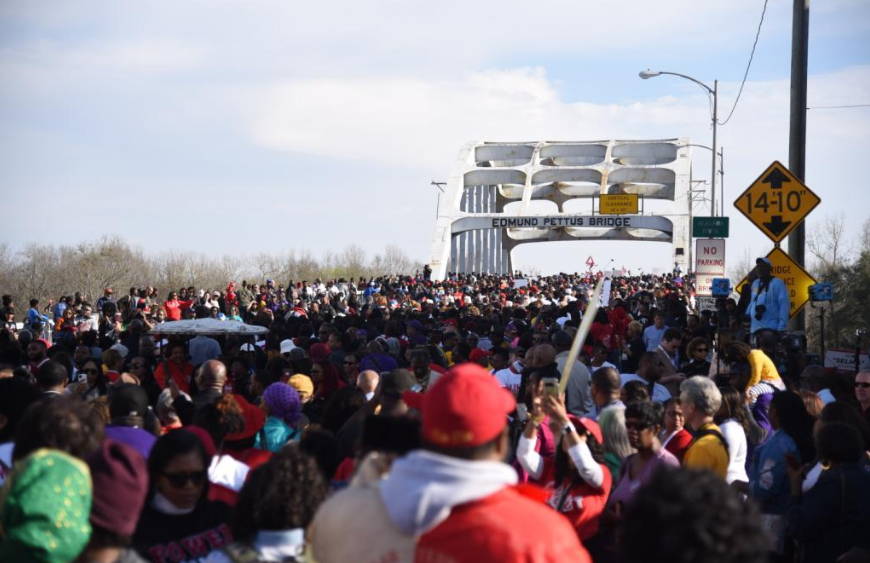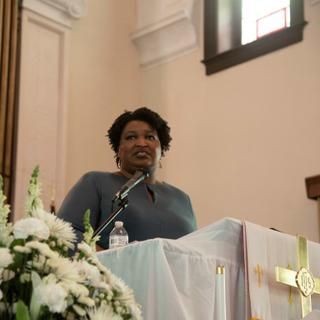SELMA, ALABAMA – Under the hot Alabama sun in the historic town of Selma, tens of thousands of demonstrators marched to the beat of drums and the rhythm of their own chants on Sunday, March 1, to commemorate the epochal 1965 Bloody Sunday March. More than 50,000 people flocked to Brown Chapel A.M.E. Church, where clergy and politicos (presidential candidates and Stacey Abrams) spoke, while outside, masses of people, courtesy of a jumbotron, listened.
Fifty-five years ago, after weeks of effort from the Student Nonviolent Coordinating Committee (SNCC) to register black voters were challenged by the state, SNCC leaders Hosea Williams and John Lewis took the struggle to the state capital in Montgomery. Leaving from Brown Chapel, about 600 people began to march the 54 miles to the governor’s mansion, but before they got out of Selma, they were beaten by police while trying to cross the Edmund Pettus Bridge. The televised images of “Bloody Sunday” shocked the nation—which enabled President Lyndon Johnson and liberal organizations to persuade Congress to pass the Voting Rights Act.
Marchers now cross that bridge on the first Sunday in March every year.“This is where civil rights began, kind of where the movement began,” says Tommy Hill, a lifelong Alabama resident. “I like to see everybody still get together, still carry on the traditions, getting out here peacefully. We’re still fighting for our rights today … but this still just reminds us of where we came from to where we are right now.”
Hill says that there’s a lot in the system that still hasn’t changed and as he thinks of history on the 55th anniversary, he’s also thinking about the current obstacles for black people in the United States to get to the ballot box.
In her talk, Stacey Abrams took the opportunity to connect Selma’s history of voter suppression with her own experience when running for governor of Georgia in 2018. Abrams spoke about her decision to found the organizations Fair Fight and Fair Count in reaction to the Republican state government throwing tens of thousands of African Americans off the voting rolls before the election. “We are going to guarantee the right to vote—because if Congress won’t, we will.” Her words were followed by a fanfare typical only to a black church.
In 2014, Alabama implemented a voter ID law, which requires photographic proof of identification for both in-person and absentee voting. The law passed in 2011, but the state waited until the Supreme Court’s 2013 decision in Shelby County, Alabama v. Holder struck down the heart of the Voting Rights Act—Section 5—before they implemented the new law. Section 5 would have required the Department of Justice to evaluate the law for possible discrimination and strike it down if they found it discriminatory.
The following year, Alabama proposed closing down driver’s license offices (which provide the photo IDs) and then started rolling back their hours of operation, mostly in the state’s Black Belt. The NAACP Legal Defense Fund fought the closures and the U.S. Department of Transportation investigated Alabama’s proposals. Two years later, the Alabama Law Enforcement Agency reopened offices with regular hours in nine majority-black counties after coming to an agreement with the USDT, but the changes and restrictions still caused confusion in the system.
Alabama has since moved to require “proof of citizenship” documents to register to vote. The secretary of state has also started purging “inactive voters” from the voting rolls, which has caused confusion at polling sites, as poll workers got people to fill out provisional ballots instead of the regular ones voters were entitled to. The Legal Defense Fund sent a letter to Alabama’s secretary of state to address the confusion in 2018, but the misunderstandings are still part of the election conversation today.
The Jubilee marchers were aware of these obstacles, but for some, they didn’t rise to the level of a major problem—at least when compared to what their forebears had to go through. Derica Green, 28, recalled that she struggled to vote while she was a student at Alabama A&M because her address didn’t match up on her ID. “It was frustrating,” she says, “but it was minute compared to what my grandmother and everybody else went through.”
Green grew up in Selma and has been coming to the Bloody Sunday commemorative marches since she was a child, alongside her childhood friend Tynechia Marshall, also 28, who agrees that there are still hurdles placed in the way of black voters. “That was the start then, and this is the start now—so now we can work to overcome all of those obstacles,” Marshall says.
Both Selma residents planned to vote in Alabama’s primary on Super Tuesday, but they were unsure whom to vote for. It helped that many presidential candidates (including some who were exiting the race) were at this year’s Jubilee: Elizabeth Warren, Amy Klobuchar, Pete Buttigieg, Tom Steyer, Joe Biden, and Michael Bloomberg. But that didn’t make the choice any easier. Indeed, many of the marchers said they didn’t feel strongly about any candidates or didn’t feel as hopeful as they used to during the Obama years.
“They [the candidates] can show up today and say this is what they’re going to do,” said Hill. “But once they get in office, if they don’t follow through on what they say, it’s like our votes are in vain.”
Stacey Abrams connected Selma’s history of voter suppression with her own experience running for governor of Georgia in 2018: “We are going to guarantee the right to vote—because if Congress won’t, we will.”
Willie Turner said he grew up watching the civil rights movement on television from Michigan, and now the 50-year-old, who has lived in Alabama for the past two decades, feels like he’s living in similar circumstances. “I call it the modern-day Jim Crow, which you know [was] ‘separate but equal.’” Today, he added, “there’s still a lot of separate but not a lot of equal.”
Turner said he has no hope in politics or any politicians—both the ones at Jubilee and back in D.C. “Not the one in office, and not the ones running now. You’ve got to pick your poison,” he said, referring to President Donald Trump and the Democratic candidates.
Despite that, Turner has never missed a chance to vote. He and Hill both told the Prospect that they’ve experienced things like finding out on Election Day that their polling sites have been moved and have had to go through the process of updating their registrations as they’ve moved to different parts of the state. But nothing could stop them from voting.
The presidential candidates’ participation did garner some appreciation from people who felt it showed respect for Selma’s history and for the original protesters who were injured, including Jimmie Lee Jackson, a black man who was shot and killed by a police officer during one of the demonstrations that led to the historic march.
But the spirit of the day did not sway everyone. Nicole Shannon, 38, said she’s been to “more Jubilees than I can count” and seen the waves of politicians that appear every year in her hometown on the first Sunday of March. She said that politics today isn’t for her, and she will not be voting this year.
Shannon says not much has changed since 1965 for black people. “We got hopeful when we got Obama,” she says. But today she’s lost her hope. “When Trump got in office, it let us know if he can get in, anybody can get in.”

